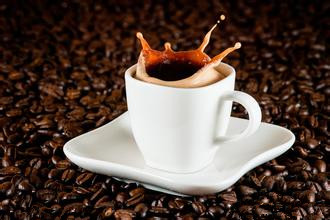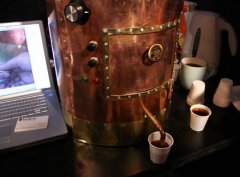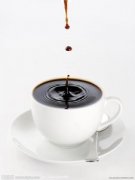Coffee basics: how to buy coffee pots and beans

Now the coffee pots on the market are all drip-type, and they are divided into Japanese style, American style and Italian style.
The Japanese coffee maker, also known as the siphon pot, has an alcohol lamp on the base and two glass balls on it. It heats the water from the lower glass ball to produce water vapor, pushes the hot water from the lower sphere to the upper pot, and then sucks back the coffee extracted from the upper glass ball after the lower pot cools. Making coffee in a Japanese coffee pot seems to have the interest of doing a chemical experiment. But burning requires a certain amount of technology, and you have to use your hands to shake the alcohol lamp below to control the temperature. It is suitable for people who have time and leisure. Japanese coffee pot requires coffee beans to be ground slightly, which is suitable for single coffee with slightly sour taste.
The American coffee maker is basically a coffee machine brewed by electric power, which is suitable for coffee roasted in medium or deep depth, with slightly fine grinding particles and bitter taste. The American coffee maker has the function of heat preservation, but if the heat preservation time is too long, the coffee will easily turn sour.
The espresso pot is a machine that allows steam to quickly extract coffee through coffee powder through high pressure and high temperature. the best temperature for brewing coffee is between 90 and 98 degrees Celsius. Household espresso pots often have a bubbling mouth to make cappuccinos, and often have the function of keeping the cup warm, which is a very important detail. If you hold coffee in a cold cup, it tastes bad.
How to choose coffee beans
No matter what kind of coffee beans, freshness is an important factor affecting the quality. When shopping, grab one or two coffee beans and chew them in your mouth. If the coffee beans are crisp and sound, and the tooth pods stay fragrant is the top grade, but it is best to squeeze them with your hands to feel whether they are solid, rather than buying empty-shell coffee.
If the coffee bean has lost its fragrance or smells stale, it means that the coffee bean is no longer fresh and is not suitable for purchase.
Freshly fried coffee beans are not suitable for immediate consumption and should be stored for a week to completely release the gas from the beans.
Generally speaking, the best drinking period for coffee is a week after stir-frying, when the coffee is the freshest and the Aroma is the best.
In addition, the purity of coffee beans is also another consideration. The expert candidate for coffee is not necessarily looking at the size of the particles, but grabbing a handful of individual coffee beans (Regional Coffee), about dozens of portions, to see whether the color of each single bean is the same, and whether the particles are similar in size and shape, so as to avoid buying shoddy products disguised as mixed beans. But if it is a synthetic bean (BlendedCoffee), it is a normal phenomenon that the size and color are different. And heavy heat and medium-deep roasting will cause coffee beans to produce oil, but lightly roasted beans, if they produce oil, indicate that they have gone bad, not only reducing aroma, but also astringent and sour taste. In short, when buying added coffee, we should pay attention to its freshness, aroma and stale flavor, and the ideal purchase quantity is to be able to drink it in half a month.
Important Notice :
前街咖啡 FrontStreet Coffee has moved to new addredd:
FrontStreet Coffee Address: 315,Donghua East Road,GuangZhou
Tel:020 38364473
- Prev

Coffee machine recommends a coffee machine that can adjust the taste of news
Have you ever heard of drinking news? Or have you ever drunk the news? Recently, there is a kind of news coffee machine called New Brews. This machine looks like an old-fashioned beer barrel, but in fact it can connect to the Internet, use RSS subscription to get the latest news, and determine the proportion of coffee beans according to the frequency of reports in various coffee bean producing areas.
- Next

Coffee pot and coffee machine use and precautions
Nowadays, many people like to buy a coffee machine, make a cup of coffee by themselves, and slowly enjoy the warmth and fun of this production process. For the general family, what problems should be paid attention to in the process of operation? At present, the common electric coffee pot on the market is generally composed of three parts: seat frame, coffee filter and coffee bottle. When working, the high temperature heating element will flow down the small part of the water storage tank.
Related
- Beginners will see the "Coffee pull flower" guide!
- What is the difference between ice blog purified milk and ordinary milk coffee?
- Why is the Philippines the largest producer of crops in Liberia?
- For coffee extraction, should the fine powder be retained?
- How does extracted espresso fill pressed powder? How much strength does it take to press the powder?
- How to make jasmine cold extract coffee? Is the jasmine + latte good?
- Will this little toy really make the coffee taste better? How does Lily Drip affect coffee extraction?
- Will the action of slapping the filter cup also affect coffee extraction?
- What's the difference between powder-to-water ratio and powder-to-liquid ratio?
- What is the Ethiopian local species? What does it have to do with Heirloom native species?

